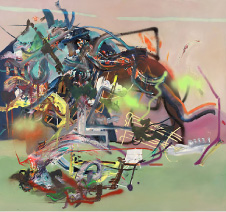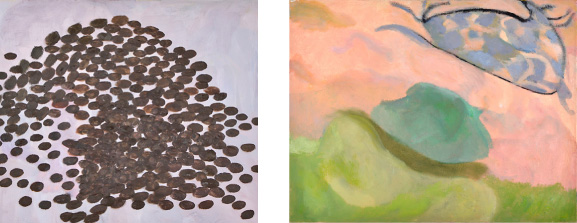
|
Imaginary spaces are spaces of the imagination, their visual construction refers back to themselves as constructions and simultaneously, in their conceiving, beyond themselves. The reality of the imaginary is a process that ruptures the idea of an anthropological inventory of artistic forms, an idea that André Malraux once probably envisioned in his musée imaginaire. The ubiquitous virtuality of digitalised images has led to an immeasurably vast space of the imaginary, which itself provokes a permanent exchange of reconstructions of a personal overview. These reconstructions make cuts in the world and thus expand the spectrum of possible feedback, inwards as much as outwards. Optimistically formulated, they recover the resilient transformation of practical life relations from the technical virtuality of global disposition. |

Reconstruction would mean regaining something left behind or lost in a changed context, experiencing it anew. Consequently, the tension between the horizontally grounded stability and the chaos of gesturally structured agglomerations of colour that characterised many of Eva Schlutius’ earlier works has been expanded since 2013 into a new pictorial dramaturgy. She develops the concealed, unstructured complexity of these energetic self-assertions into an unconcealed spatial transparency. Through the release of the figurative moment rescinded in this abstraction, the gestalt character of the constructive-expressive, intertwined gestures leads to ‹putting all the cards on the table›. It correlates the magic of the constructivity of visual spaces with the narrative magic of painterly gestalt character as an expression of dreamlike and exotic imaginations of girls and fairy tales, of animals and plants. |

Looking at Eva Schlutius’ paintings in the variety of their forms of abstraction and their interrelationship means placing one’s cards on the table, it means confronting one’s own conceptions in the surprising possibilities of constellations that arise from the dissimilarity of these paintings, encountering in them the enabling power of the imagination. We interact with an imaginary grammar of space that follows the idea of the construction of its representability and describability from primordial, bodily experience. Painting as painting reconstructs this experience as the manual process of a practice reflected in itself and in mimetic concentration. |

That we think of space starting from our bodies and its borders is just as little lost in our everyday self-conception as the viewing of a sunset as an image. In both cases, however, the bodily self-reference must be comprehended in the tension of forms of abstraction running contrary to each other: a theoretically grounded conception of reality on the one hand and the projection of a holistic sensation of the depictability of its gestalt character on the other. The existential step through the undepictability of theoretical abstractions raises awareness for the reality of breakages in the visual possibilities of localising sensuous experiences. |


This twofold abstraction is reflected in the constructivity of colour as material event. Its painterly self-referentiality is an expression of a linguistic meaning grounded in the experience of space, whose articulation intuitively precedes its meanings derived from this experience of space. This is similar to how we as viewers – and previously the artist as the observer of herself – follow the cleared paths of explorations and voyages of discoveries of artistic sensuality, following the trail of the ungraspable sensuality of imaginary shapes. If we spin this thought further it will lead us to a contemporary approximation of the Wonderland that Alice once traversed. |

Eva Schlutius’ paintings are at variance with the verbal directness of her titles’ designation, in the reciprocity of associations that are open as much as directed. The painterly world becomes its own linguistic area that – not always conventionally – reconnects the titles with existing linguistic conventions. Eva Schlutius’ incursions in this world lead to a visual kingdom of a grammar of imaginary spaces that narrates itself. Points, lines, and surfaces are related to one another and they thus lead beyond themselves, unilaterally as well as scenically arranged. In the imaginary space of the self-encounter ‹putting the cards on the table› becomes the freedom of personal openness in dealing with Eva Schlutius’ paintings. If the cards favour us we will find the entrance to our own Wonderland. |

Wolfgang Siano Berlin, 26 July 2016
|